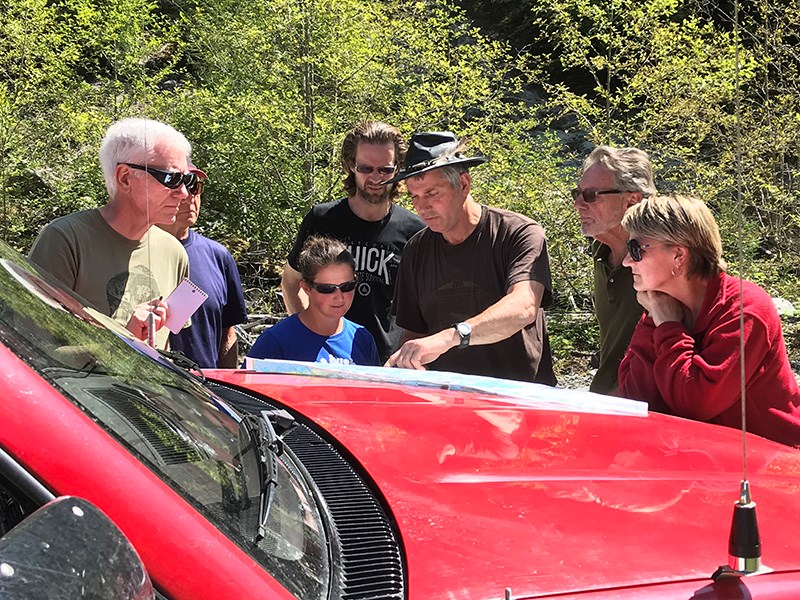Powell River Search and Rescue Society is engaged in a training program with 17 new members taking part in becoming qualified to participate in search and rescue activities.
“We’ve been interrupted by COVID-19 but we’re back at it now,” said Russell Storry, president of Powell River Search and Rescue and one of four qualified search managers.
Those enlisting go through a criminal record check, driving record check, they must sign a confidentiality agreement, be comfortable in the wilderness and have to be registered with Emergency Management BC (EMBC), which provides safety benefits. This is so if somebody gets injured on a task, or a training event, there is coverage.
In terms of preparation, new volunteers must undergo about 80 hours of training.
“There’s field work and classroom work,” said Storry. “There are modules coordinated by the Justice Institute of British Columbia (JIBC). We have instructors who have taken training from JIBC to put the course on and represent them in training.”
Storry said people who take the training to participate in Powell River Search and Rescue activities are committed.
“It’s quite exciting for all of us,” said Storry.
He said having new members is helpful because a few longer-term members have retired from active duty. Some members have been involved with the organization for as long as 40 years.
“It’s great to have younger people coming up and getting involved, meeting all of the new standards and qualifications that are required,” said Storry.
In terms of carrying out its function, Storry said Powell River Search and Rescue is tasked by the emergency coordination centre (ECC) out of Victoria.
“We don’t move without a task number,” said Storry. “Organizations like the RCMP would call in to ECC and ECC calls us out. We usually get a message with a rough idea of what the situation is and a contact name and number for a person with the lead agency, and we call them and get more details and go with unified command from there.”
Typically, activities would involve searching for a subject who is lost, or being involved in a medical rescue.
“Our role is to locate, assess, stabilize, report and transport and hand off to the served agency, like BC Ambulance,” said Storry.
In these instances, first aid might be required, and all members of Powell River Search and Rescue have first aid certification.
In carrying out rescues, for the participants, fitness is an asset, as is being comfortable in the bush.
Powell River Search and Rescue is housed in the old Cranberry fire hall on Drake Street. The organization has two rescue command vehicles, which are crew cab trucks with boxes on the back that can carry a lot of equipment; one truck can actually carry a person in a stretcher as well. The organization also has two all-terrain vehicles to assist with search activities and a command trailer can be transported as an incident command post.
“It’s like a fire department where you just have to keep practicing and getting used to using all of the equipment,” said Storry. “It’s important to stay current.”
He said training is important to the organization, and it has upped the frequency from once a month to two or three times a month.
Storry said the organization now has more horsepower in its command centre to assist in its search capabilities. He said they have the capability for one person to monitor the radio, and there is now a wide-area repeater on Mount Pocahontas on Texada Island that has improved capacity. Radios have GPS capability. A computer screen shows where people are.
Powell River Search and Rescue has also received support from qathet Regional District, which donated its old map plotters to assist with the organization’s function. Search and rescue is doing as much as possible to use technology to assist its efforts.
In terms of annual callout, Powell River Search and Rescue peaked in 2018 with 30 calls, but the average in the community during the last few years has been about 10 callouts per year. The coverage area is the same as the Powell River RCMP detachment, which goes from Saltery Bay to the head of Bute Inlet and back into the mountains.
Storry said calls tend to be more for medical rescues than looking for lost people. He said he recommends people embrace adventure smart apps for trip planning, which can be of great assistance to searchers, should people get lost or injured. He said filing the information, which is like an aviator would do to prepare a flight plan, can be really helpful for finding people.
Powell River Search and Rescue now has reliable funding from the province, an administrative structure, an operational readiness and response structure, so it is well positioned to take on the challenges as they come.



